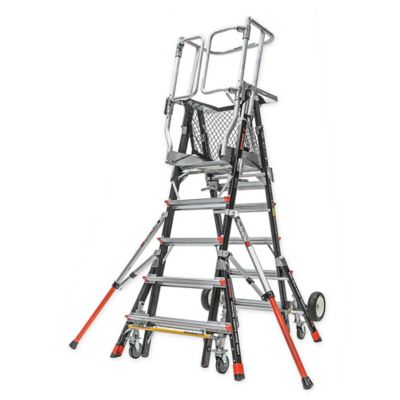American national standards for ladders fixed safety requirements the safety standard for fixed ladders contains an entire section devoted to these enclosures.
Caged ladder standards.
The track of a ladder safety system that consists of a flexible cable or rigid rail attached to the fixed ladder or immediately adjacent to it osha.
Cages must extend 42 inches above the top of the landing.
The new regulations change this requirement dramatically.
Optional security cover prevents unauthorized access.
Osha requires a cage when the distance from the floor to the top rung is more than 20 feet.
Cages start between 7 and 8 feet from the ground and extend beyond the top rung by 42 with a walk through exit.
For starters prior to the new ruling the only real guidance on fixed ladders came from the construction standards osha more 1926 1053 a 18 required the use of cages wells ladder safety devices or self retracting lifelines for fixed ladders of 24 feet or more.
Section 1910 28 establishes the employer s duty to provide fall protection for employees on fixed ladders and 1910 29 specifies the criteria for fall protection systems for fixed ladders.
Fixed ladders provide stability when ascending to an elevated work surface because they are fastened to the building or a secure surface.
The ladder of steel construction is exactly 24 feet in height 18 inches in width and terminated at the roof scuttle.
The requirement for a cage comes when you have a fixed ladder longer than 20 feet.
Figure d 3 example of counterbalanced hatch cover at roof.
Previously a fixed ladder with a cage required a landing platform at a maximum interval of 30 feet.
A cage or well on a fixed ladder prevents lateral movement containing the individual climbing the ladder and offering the comfort of a surrounding safeguard.
Here are the basics of the requirements.
Fixed ladders without cages must now have a landing platform at maximum intervals of 150 feet.
Figure d 2 slide step fixed ladder sections.
Fixed ladder that is designed to surround the climbing space of the ladder.
What s changed for fixed ladder standards under osha 1910.
The regulations say that if a fixed ladder is taller than 20 feet you are required to have a cage which meets all the requirements of 29 cfr 1910 27 d.
It covers five rungs and is secured by two hooks at.
1910 28 b 9 ii b ladders with cages must now have a landing platform at maximum inter.
A cage also is called a cage guard or basket guard osha carrier.
In the past osha has required cages for fixed ladders taller than 20 feet but as of january 2017 fall protection is required on fixed ladders.
Ladder and cage come unassembled for mounting flexibility and lower freight costs.
Fixed ladders shall be provided with cages wells ladder safety devices or self retracting lifelines where the length of climb is less than 24 feet 7 3 m but the top of the ladder is at a distance greater than 24 feet 7 3 m above lower levels.

